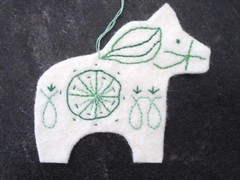 ...is for Unscheduled.
...is for Unscheduled.Anyone who knows me would be thinking, "What do you mean? You have a schedule and follow a routine with homeschooling."
That's true. I have a plan for the year and know what I want Sophia and Olivia to do and learn each week.
There are activities that the girls participate in that happen on certain days and times - homeschool co-op and piano lessons on Monday; Sophia's harp lesson on Tuesday; church choir practice on Wednesday with singing at two services on some Sundays; and Olivia's speech therapy and special education sessions on multiple days and times.
Each day during the school week there is a routine and rhythm that we follow. On days when there are activities outside the home, the schedule is modified to include them.
Generally, we wake up, have breakfast, take care of the horses, and then begin homeschooling. We take a break for lunch which we eat together. The girls play outside for a bit and then we resume homeschooling. After we are done homeschooling, the girls are free to do what they want to do until dinner which we eat together. In the evening, we read together, listen to books on CD, and play.

Sophia and Olivia on a nature walk/study with Bailey (the pony).
We focus on the more challenging subjects such as math and reading in the morning while leaving the "easier" subjects - such as geography, art, and home economics - in the afternoon. (These are not the only subjects that the girls study...they're just a few examples.)

Olivia working on reading skills.
What I'm referring to when I think of "unscheduled" is having the flexibility to sit down with the girls each week and say, "For math this week you need to do lessons 1-5. For penmanship you need to do lesson 1. For reading, I would like you to read chapters 1-15 this week," and so on.
By having blocks of time that we homeschool, the girls and I can spend as much time as needed on a particular activity. So, for example, if I'm reading a book aloud for history and we are all captivated by it, I will read until we are ready to take a break.

Sophia having fun one afternoon on the ice. She and Olivia were having so much fun skating that we ended up staying longer than we planned.
If I followed a strict schedule and didn't deviate from the set times, then there would be many times I would have to tell the girls, "We're done with this subject for the day. Time to move on to the next activity."
I can only begin to imagine the frustration the girls would feel with being interrupted right in the middle of being focused on their work and being told to leave something uncompleted. If they are focused and/or enjoying what they are doing, I see no purpose in interrupting their work unless there's some sort of emergency or dire need at stopping (which doesn't happen frequently, thankfully).
With homeschooling, I like having the ability to give the girls their assignments for the week and/or day and then letting them determine how they are going to reach these goals. If they want to do all their grammar lessons for the week in one day...fine. If they have the energy and motivation to do two math lessons in one day...great.

Olivia learned how to make a circuit. She was happy to see the light bulb work. Success!
The girls - who are 8 and 10 years old - are learning about time management and knowing their strengths and areas of challenge. They know that devoting time each day to practicing the piano or harp will be easier than practicing for 3 1/2 hours at one time because they didn't budget their time well.

Sophia playing the harp and learning a new song.
By not giving Sophia and Olivia a set schedule each day with specific times for each subject, it allows them to fully use their minds and skills in self-direction. Also, with learning disabilities and sensory issues, there has to be flexibility and freedom to work at one's pace during the day...at least that's what works for us.

Olivia was needle-felting a heart for Valentine's Day. She was ready to start homeschooling right away at 7:00 in the morning and chose to start with art/creative expression.
Having a homeschooling plan that details goals and activities for each week is critical to staying on track and meeting educational goals. Being flexible and committed to an unscheduled way of life and way of homeschooling is essential to making learning fun and engaging.

Sophia spinning in a Hmong outfit that was part of an interactive exhibit at the Science Museum.














































